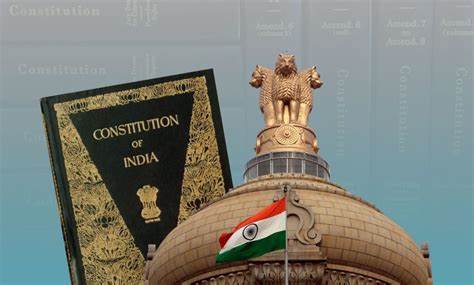Recent Posts
Subscribe
Sign up to get update about us. Don't be hasitate your email is safe.

 Article
Article
The Constitution of India is the supreme law of India. It frames fundamental political principles, procedures, practices, rights, powers, and duties of the government. It imparts constitutional supremacy and not parliamentary supremacy, as it is not created by the Parliament but, by a constituent assembly, and adopted by its people, with a declaration in its preamble. Parliament cannot override it.
The world’s longest constitution is the Indian’s constitution. At its commencement, it had 395 articles in 22 parts and 8 schedules. It consists of approximately 145,000 words, making it the second largest active constitution in the world. Currently, it has a preamble, 25 parts with 12 schedules, 5 appendices, 448 articles, and 101 amendments
(1) India, that is Bharat, shall be a Union of States.
(2) The States and the territories thereof shall be as specified in the First Schedule.
(3) The territory of India shall comprise —
(a) the territories of the States;
(b) the Union territories specified in the First Schedule; and
(c) such other territories as may be acquired.
(1) India shall be a Union of States.
(2) The States shall mean the States for the time being specified in Parts I, II and III of the First Schedule.
(3) The territory of India shall comprise-
(a) The territories of the States;
(b) The territories for the time being specified in Part IV of the First Schedule; and
(c) Such other territories as may be acquired.
(1) India, that is Bharat, shall be a Union of States.
(2) The States and the territories thereof shall be the States and their territories specified in Parts A, B and C of the First Schedule.
(3) The territory of India shall comprise —
(a) the territories of the States;
(b) the territories specified in Part D of the First Schedule; and
(c) such other territories as may be acquired.
Draft Article 1 (Article 1 of Constitution of India 1950) was debated on 15 and 17 November 1948, and 17 and 18 September 1949. The Draft Article declared India as a ‘Union of States’ and went on to define India’s territory.
Most members were confused as to why India was described as a ‘Union of States’, instead of a ‘Federation’ which was more appropriate. While presenting the Draft Constitution on an earlier date, the Drafting Committee Chairman had explained that ‘Union of States’ was used to ensure and clarify that States did not have the right to secede from India.
A Member wanted to rename ‘India‘ to ‘Bharat’ as the latter had more historical pedigree. Another Member introduced an amendment to use both ‘India’ and ‘Bharat’ in the Draft Article. The Drafting Committee Chairman had through an amendment, suggested that the Draft Article say ‘India, that is Bharat, shall be a Union of States’. Except for one member who found the phrasing inelegant, the amendment won the support of the house.
The Assembly rejected all amendments to the Draft Article except those introduced by Drafting Committee Chairman. It adopted the Draft Article on 18 September 1949.